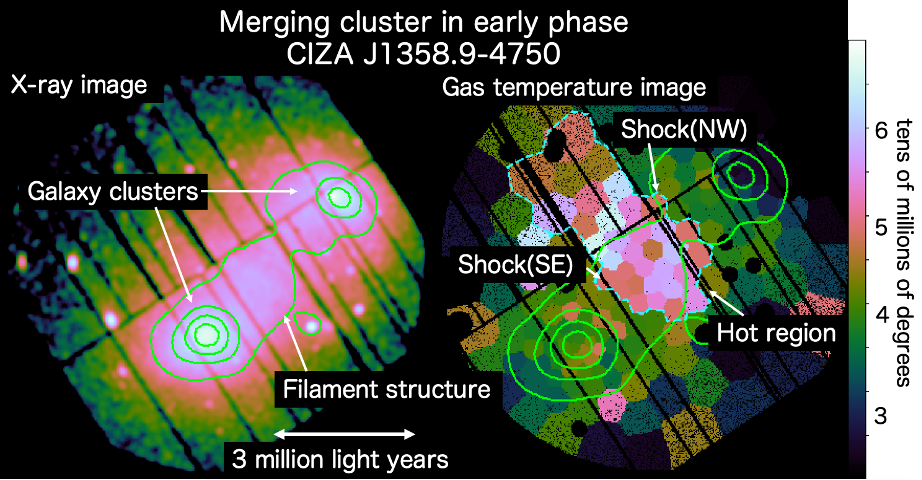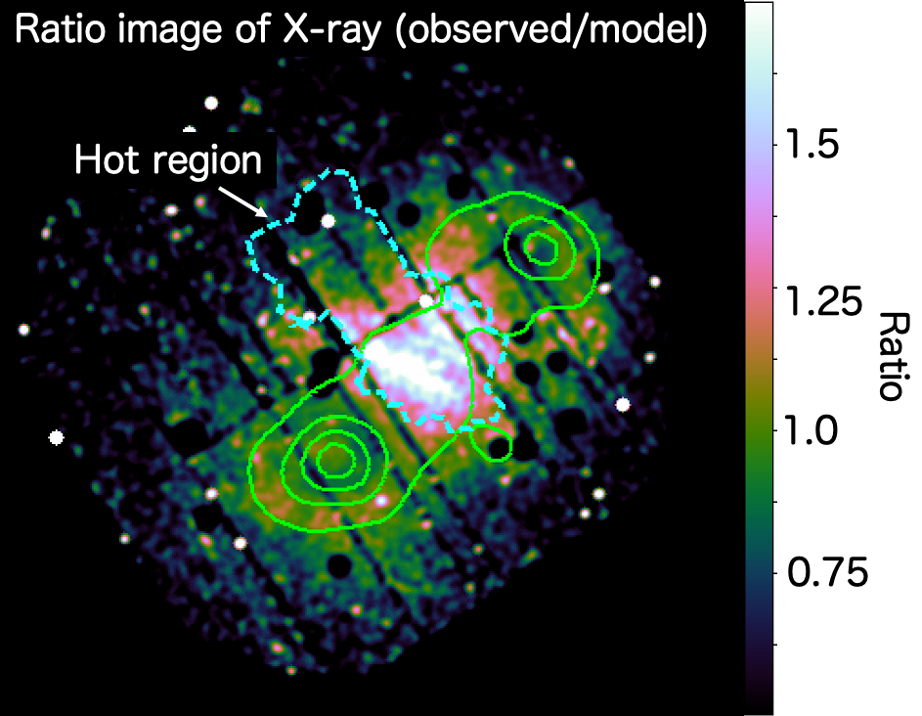[Research] Exploring the energy flow within the largest shock waves in the universe
Abstract
Our group led by Associate Professor Kazuhiro Nakazawa at Nagoya University/KMI, and doctoral course student Yuki Omiya at the Graduate School of Science, in collaboration with the National Astronomical Observatory of Japan, Tokyo University of Science, Hiroshima University, Saitama University, JAXA Institute of Space and Astronautical Science, Tokyo Metropolitan University, Netherlands Institute for Space Sciences, and Toho University, succeeded in estimating the length, width, depth, and merging velocity of the shock wave just born in the nearby merging galaxy cluster CIZA J1358.9-4750, and confirmed that it released an energy of 2.3 × 1038 W. The data from the European X-ray astronomy satellite, XMM-Newton was used.
Galaxy clusters are the largest self-gravitating objects in the universe and host a massive volume of high-temperature gas that emits bright X-rays. The cluster merger is the largest astronomical event in the universe, generating a huge shock wave of 3 million light-years square. In astronomy, it is generally difficult to measure the depth of a celestial object. In our study, we determined the depth by taking advantage of the fact that the two clusters have just collided, and its original shape can be reasonably estimated. By determining the velocity of the shock front from the temperature distribution of the high-temperature gas and multiplying it by the “length, width, and depth”, we estimated the amount of kinetic energy released in the shock front, being converted into “heat”, particle acceleration, and magnetic-field amplification.
Our research result was published in the February 2023 issue of the Publications of the Astronomical Society of Japan (PASJ). In a related paper, Kurahara et al. (PASJ, December 2022) discovered “synchrotron radio emission” by accelerated electrons and amplificated magnetic fields around the shock front. Its luminosity is estimated to be ~3.5 × 1033 W. These results give us a conversion efficiency of about 10-5. It is just one example, but by understanding the distribution of conversion efficiency, we will clarify what is happening under the huge shock wave in the merging cluster.
Scientific Background
The universe has evolved through gravitational accretion of matter, forming stars and galaxies, and repeatedly colliding and merging in the process since the Big Bang about 13.8 billion years ago. Galaxy clusters are the largest self-gravitating system in the universe, the majority of which is made of dark matter. Compared to the sun, it has nearly 1015 times larger (10 million light-years) and a has a mass of about 1045 kg. In addition to numerous galaxies, it hosts a high-temperature gas of approximately 10-100 million Kelvin that emits bright X-rays.
The galaxy clusters collide with each other and release enormous gravitational energy. It is the largest energy-release event in the universe. Huge shock waves, approximately 3 million light-years square, are generated in the merging process, injecting enormous energy into the high-temperature gas. This energy is converted into thermal and non-thermal energies, which accelerate particles and amplify the magnetic field. Understanding the conversion efficiency in these processes is of great significance in elucidating the growth of the high-temperature gas in the galaxy cluster.
However, to evaluate these numbers, one needs to know the three-dimensional structure of the shock. Estimating their initial state and shape in the midst of intense mixing of each cluster’s gas is necessary. Therefore, our research group focuses on the merging cluster in its early phase, which is rare.

Details
We focused on the galaxy cluster CIZA J1358.9-4750 (hereafter CIZA1359), which is approximately 1 billion light-years away from us. CIZA1359 is an object with two galaxy clusters located about 4.5 million light-years apart. In X-rays observation, we can see “bridge” which is a filament structure connecting the centers of two clusters.
Observation data in Suzaku, the Japanese X-ray astronomy satellite, showed a clear region of enhanced temperature between the two clusters. The presence of a shock wave suggests that CIZA1359 is cluster merging in the early phase.
We tried to elucidate the structure in CIZA1359 using observation data in XMM-Newton, the European X-ray astronomy satellite, which has 20 times higher angular resolution compared to the Suzaku satellite. Figure 1 shows an X-ray emission intensity image and a gas temperature image. While the temperature near the center of each galaxy cluster is about 40 million Kelvin, between clusters the high-temperature gas with about 60 million Kelvin is extended with about 1.5 million light-years wide and 4 million light-years in perpendicular to the merging axis. It is evident that the collisions generate two enormous shock waves 4 million light-years apart and heat the gas flowing back in the direction of the merge axis. The velocity of the two shock waves is estimated to be about 1500 km/s based on the temperature distribution of the hot gas, and the merging age is estimated to be around 300 million years.

How much kinetic energy does this young shock wave release? We modeled the pre-collisional gas distribution by taking advantage of the approximate point symmetry of the two clusters and the fact that the shock wave does not reach the individual centers of the clusters.
Figure 2 shows the ratio of the observed X-ray emission intensity image to a model of the X-ray emission intensity image assuming no shock wave effects. There is an enhanced region between the cluster centers, with a factor of approximately 1.8, which is consistent with the high-temperature structure indicated in the temperature map.
We estimated the depth of the shock wave to be about 3 million light-years based on the conservation law of hydrodynamics and a simple spatial model. By multiplying width, depth, and velocity of the shock wave, we determined the kinetic energy of the northwestern shock wave is 2.3 × 1038 W. This value corresponds to one billion times the energy consumed by the sun in a year, all released within just one second.
Dr. Kurahara and his research group at the Mizusawa VLBI of the National Astronomical Observatory of Japan analyzed radio observation data from the uGMRT (upgraded Giant Metrewave Radio Telescope). They found that diffuse radio emission structure on the northwest side of CIZA 1359 merger bridge caused by electrons accelerated to nearly the speed of light spread across the shock wave surface. The luminosity of this emission was calculated to be 3.5 × 1033 W. By comparing it to the input energy of the shock wave, the conversion efficiency was determined to be approximately 10-5.
This is just one example, but understanding the distribution of conversion efficiency will allow us to clarify what is happening under the largest shock wave in the cluster merger.
Conclusion
This study successfully discovered the presence of two shock waves in the nearby galaxy cluster CIZA J1358.9-4750. By constructing a simple model, we were able to estimate the kinetic energy consumed by the shock waves based on observations, which had been difficult to estimate until now.
Additionally, capturing and quantifying the conversion of particle acceleration energy from kinetic energy in the shock waves during the relatively young stage of merging cluster, using both X-ray and radio observations, is an important achievement that enhances our understanding of the evolution of galaxy clusters.
With the development of recent low-frequency telescopes such as MeerKAT and LOFAR, as well as new observations from the X-ray astronomical satellite “XRISM” scheduled for launch this year, our understanding of the energy flow consumed by the giant shock waves generated from galaxy cluster collisions is expected to deepen further.
Yuki Omiya, who led this analysis, commented:
By conducting a detailed reanalysis of past data in this study, we have successfully discovered the existence of two ‘newborn giant shock waves’ in merging clusters. These shock waves have a width and depth 30 times larger than the diameter of our Milky Way galaxy, and this is the first time they have been observed. Furthermore, by modeling the overall collision, we were able to estimate the kinetic energy of these shock waves. It is fascinating how analyzing past data from a new perspective can lead to new discoveries in scientific research.
Synchrotron radio observations using next-generation radio telescopes have captured evidence of particle acceleration already taking place in the ‘newborn giant shock waves’ we discovered. By utilizing the X-ray astronomical satellite XRISM, scheduled for launch this year, we will be able to capture the turbulent nature of the high-temperature gas generated by the motion of the shock waves for the first time. These two breakthroughs will allow us to unravel the intense high-energy phenomena created by the immense energy generated within the cosmic giant shock waves.
Paper Information
- Journal : Publications of the Astronomical Society of Japan (PASJ)
- Title : XMM-Newton view of the shock heating in an early merging cluster, CIZA J1358.9−4750
- Authors : Yuki OMIYA, Kazuhiro NAKAZAWA, Kyoko MATSUSHITA, Shogo B. KOBAYASHI, Nobuhiro OKABE, Kosuke SATO, Takayuki TAMURA, Yutaka FUJITA, Liyi GU, Tetsu KITAYAMA, Takuya AKAHORI, Kohei KURAHARA, and Tomohiro YAMAGUCHI
- DOI : https://doi.org/10.1093/pasj/psac087
Contact
Experts contact
Kazuhiro Nakazawa
E-mail: nakazawa_at_u.phys.nagoya-y.ac.jp
Media contact
Shota Takahashi
Email: pr-office_at_kmi.nagoya-u.ac.jp
KMI / Nagoya University
Related Links
- 2023-06-15 Unburying CIZA Galaxy Cluster – NAOJ
- 2023-06-15 Unburying CIZA Galaxy Cluster – NAOJ Mizusawa



